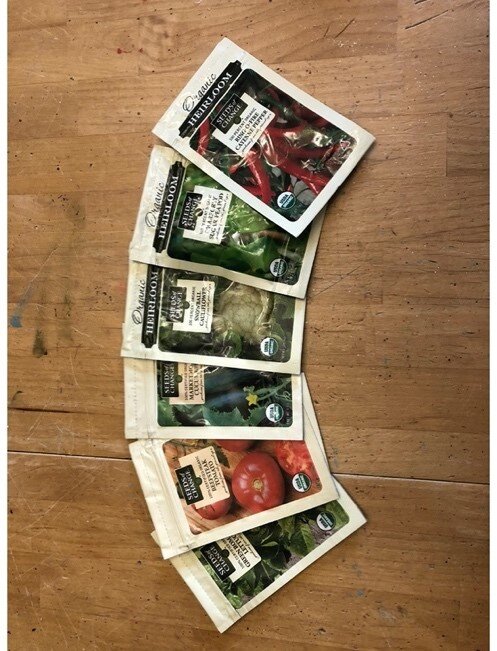Written by Lily Bonasso

The days are finally getting longer, and all of the spring flowers are beginning to bloom! In light of the changing of the seasons, one of the best ways to celebrate what the Earth has to offer is by planting a vegetable garden to care for. Not only does it give you a project to spend time on (which, let’s admit, is something we all need right now), it also yields a wonderful harvest by the end of the summer. You will find yourself feeling closer to the planet as you experiment with methods of growing and feel a sense of pride in harvesting produce that you have grown in your own backyard!
There are two main ways to begin your own vegetable garden– sprouting your plants from seeds or purchasing already started seedlings from a store. Either route will work well, especially in this region. If you do decide to plant your own seeds, there are some great product options on the market. For example, this year I chose to purchase from a company that contributes some of its profit to community gardens throughout the country.
Ideally, seeds should be planted during April, so that they have sufficient time to grow inside before being transplanted outside. Starting seeds is not difficult at all, especially given the plethora of growing kits available. Each is a bit different, but generally kits include individual cells with a pellet of growing medium for each cell. After being soaked in water, the pellets will expand, and a couple seeds can be buried lightly in each one. It will end up looking a bit like the photo to the left. Just follow the instructions of the kit, and you’ll be golden!

In reality, you will be planting more seeds than you will end up growing in your garden. The hope is that a few of the seedlings thrive enough to be transplanted once the weather is warmer! After planting the seeds, they will need to be covered lightly in order to germinate. At this stage, they do not need any light, but it is important that you check to make sure that moisture is being retained and that the soil receives water if it dries out. Once the seedlings sprout, the covering will need to be removed and they will need to receive light every day. If you have a sunny spot in the house, that is perfect. If not, another option would be to utilize LED grow lights. By the time the weather is consistently warm, some of the seedlings will be strong enough to transplant outside!
If you choose to use pre-grown seedlings, then you get to skip all of the above. Make sure the plot of land you use has adequate space for the plants you are growing and is free of weeds. Don’t be overzealous! Just because there is enough room on top of the soil for the plant does not mean that there will be enough room below the surface for proper root growth. Each plant should include a description that indicates how far apart the seedlings should be planted. This information can also be easily accessed online. Once the seedlings are planted – whether they are homegrown or purchased – the rest is fairly simple! During the growing season, make sure the plants do not dry out, but be careful not to overwater them. Be sure to check each plant every day to ensure that itis healthy.

Here are some quick helpful hints that I have learned from my own experiences and collected from more experienced gardeners:
-
Plants that are long or tall (cucumbers and tomatoes, specifically) can be easier to manage with a trellis. These can be purchased from a store or made out of anything you can find around the house.
-
Never plant outside before Mother’s Day. After this date, you can guarantee that there will not be an overnight frost.
-
Confine invasive-type plants to pots (herbs, mint, catnip, etc.)
-
Marigold flowers can be planted around the perimeter of the garden bed to keep out deer and pests and add some color to your garden!
-
Don’t forget to check under the huge leaves of large plants, you don’t want to miss a crop and let it grow too large or rot! The best produce is just the right size – not too large, not too small.
-
Laying down newspapers over the soil with a layer of grass clippings on top for weight, can assist in keeping out weeds, but allows water to absorb into the soil. Just tear some holes for the vegetable plants to grow through.
-
If you grow tomato plants, burying a portion of the lower stem underneath the soil is said to produce richer root development and a greater harvest.

